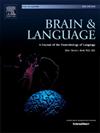西班牙语地区变体的语义加工:口音熟悉度的作用
IF 2.3
2区 心理学
Q1 AUDIOLOGY & SPEECH-LANGUAGE PATHOLOGY
引用次数: 0
摘要
研究表明,与听者自己不同的非母语口音会阻碍理解,正如中介语语音可理解性益处(ISIB)所描述的那样。虽然在非本地环境中进行了广泛的研究,但对本地区域品种的研究较少,结果好坏参半。本研究考察了母语听众对地理上遥远的西班牙语变体的实时句子处理。说墨西哥西班牙语的人听的是与他们自己的口音相匹配(墨西哥)或不匹配(西班牙半岛,波多黎各)的口音,以及非英语口音的西班牙语。行为结果显示,所有品种的理解能力都很高。ERP发现语义违背N400对墨西哥口音和熟悉的西班牙半岛口音有影响,但对不太熟悉的波多黎各口音没有影响。非母语英语口音的西班牙语出现了N400和晚期消极性。结果表明,在实时句子处理过程中,不熟悉的母语变体会对词汇语义的获取产生挑战,而熟悉的口音则会促进词汇语义的获取。研究结果支持了在匹配语音之外的区域变体中普遍存在的语言内加工优势,进一步完善了ISIB假设。本文章由计算机程序翻译,如有差异,请以英文原文为准。
Semantic processing of regional varieties in native Spanish listeners: the role of accent familiarity
Research shows that nonnative accents differing from a listener’s own can impede comprehension, as described by the Interlanguage Speech Intelligibility Benefit (ISIB). While extensively studied in nonnative contexts, native regional varieties have been less frequently studied, with mixed findings. This study examined native listeners’ real-time sentence processing of geographically distant Spanish varieties. Mexican Spanish speakers listened to accents that matched (Mexican) or mismatched (Peninsular Spain, Puerto Rico) their own, along with nonnative English-accented Spanish. Behavioral results showed high comprehension across all varieties. ERP findings revealed semantic violation N400 effects for the Mexican and familiar Peninsular Spain but not for the less-familiar Puerto Rican accent. An N400 and late negativity appeared for nonnative English-accented Spanish. Results indicate that less-familiar native language varieties challenge, while familiar accents facilitate, lexico-semantic access during real-time sentence processing. Findings support a generalized intra-language processing benefit for regional varieties beyond matched speech, further refining the ISIB hypothesis.
求助全文
通过发布文献求助,成功后即可免费获取论文全文。
去求助
来源期刊

Brain and Language
医学-神经科学
CiteScore
4.50
自引率
8.00%
发文量
82
审稿时长
20.5 weeks
期刊介绍:
An interdisciplinary journal, Brain and Language publishes articles that elucidate the complex relationships among language, brain, and behavior. The journal covers the large variety of modern techniques in cognitive neuroscience, including functional and structural brain imaging, electrophysiology, cellular and molecular neurobiology, genetics, lesion-based approaches, and computational modeling. All articles must relate to human language and be relevant to the understanding of its neurobiological and neurocognitive bases. Published articles in the journal are expected to have significant theoretical novelty and/or practical implications, and use perspectives and methods from psychology, linguistics, and neuroscience along with brain data and brain measures.
 求助内容:
求助内容: 应助结果提醒方式:
应助结果提醒方式:


